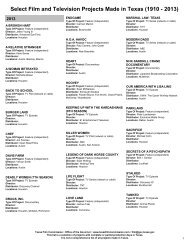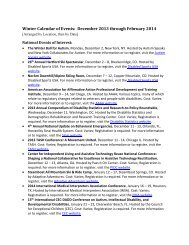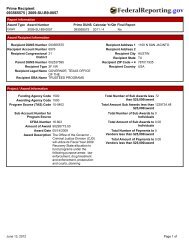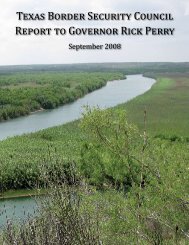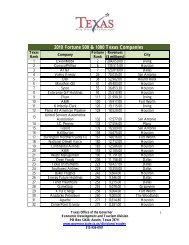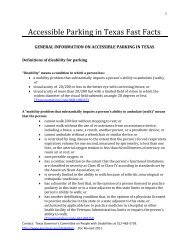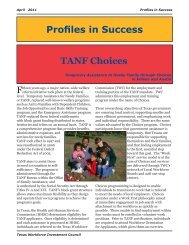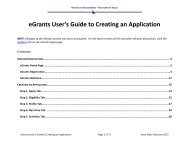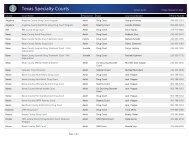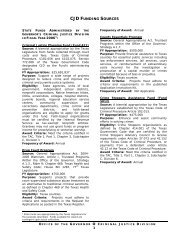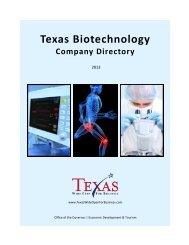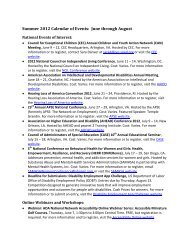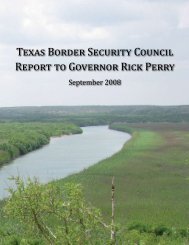People with Disabilities: A Texas Profile
People with Disabilities: A Texas Profile
People with Disabilities: A Texas Profile
You also want an ePaper? Increase the reach of your titles
YUMPU automatically turns print PDFs into web optimized ePapers that Google loves.
Concluding Comments<br />
This study provided a demographic overview of individuals <strong>with</strong> disabilities for both the U.S. and <strong>Texas</strong>.<br />
A demographic description of the U.S. population of individuals <strong>with</strong> disabilities was first presented to<br />
provide both a general overview and a context for the analysis of the <strong>Texas</strong> population. The <strong>Texas</strong><br />
population of individuals <strong>with</strong> disabilities was then detailed using 2011 ACS microdata <strong>with</strong> a focus on<br />
the characteristics of civilian labor force participants <strong>with</strong> disabilities.<br />
National data indicate the numbers of individuals <strong>with</strong> disabilities have been increasing since 2008;<br />
however, the percentages of individuals <strong>with</strong> disabilities have consistently made up approximately 12<br />
percent of the total civilian noninstitutionalized population. Women are more likely to have a disability<br />
than men and the average age of the population of individuals <strong>with</strong> disabilities is older than the average<br />
age of the population <strong>with</strong>out disabilities. Individuals <strong>with</strong> disabilities most frequently reported having<br />
ambulatory difficulties. The unemployment rate for individuals <strong>with</strong> disabilities is higher than for<br />
individuals <strong>with</strong>out disabilities and the average yearly income for individuals <strong>with</strong> disabilities is less than<br />
for individuals <strong>with</strong>out disabilities at every educational attainment level.<br />
In <strong>Texas</strong>, the average age of a labor force participant <strong>with</strong> a disability was 47.5 in 2011. Approximately<br />
29.7 percent of Texans age 16 and older <strong>with</strong> disabilities (797,326 individuals) were labor force<br />
participants in 2011. Individuals <strong>with</strong> disabilities accounted for 6.4 percent of civilian labor force<br />
participants age 16 and older in <strong>Texas</strong>. The three industries that employed the largest numbers of labor<br />
force participants <strong>with</strong> disabilities in <strong>Texas</strong> were construction, elementary and secondary schools, and<br />
restaurants and other food services. Labor force participants <strong>with</strong> disabilities who worked full time<br />
earned an average salary of $39,826, whereas part time workers earned $10,930.<br />
The demographic overview of individuals <strong>with</strong> disabilities presented in this report is meant to assist<br />
policy makers and program planners in the design and implementation of relevant programs and<br />
services. This study supports policy recommendations made by the Committee on <strong>People</strong> <strong>with</strong><br />
<strong>Disabilities</strong> (2013) to the 83rd <strong>Texas</strong> Legislature regarding individuals <strong>with</strong> disabilities in the labor force.<br />
In order to support full employment opportunities for individuals <strong>with</strong> disabilities, the Committee’s labor<br />
force recommendations concern educating employers about legal requirements, supporting an inclusive<br />
business climate, promoting accessible workplace technology, enhancing existing state services and<br />
encouraging an integrated approach to service delivery, and responding quickly to emerging trends,<br />
including the aging of the workforce.<br />
Individuals <strong>with</strong> disabilities can enhance workforce diversity and offer employers the skills, knowledge<br />
and experience that <strong>Texas</strong> businesses need to thrive. These individuals can strengthen the current and<br />
future <strong>Texas</strong> economy and are a valuable resource for <strong>Texas</strong> employers. The <strong>Texas</strong> workforce system<br />
must ensure that employers have access to every potential skilled worker.<br />
<strong>Texas</strong> Workforce Investment Council 33



